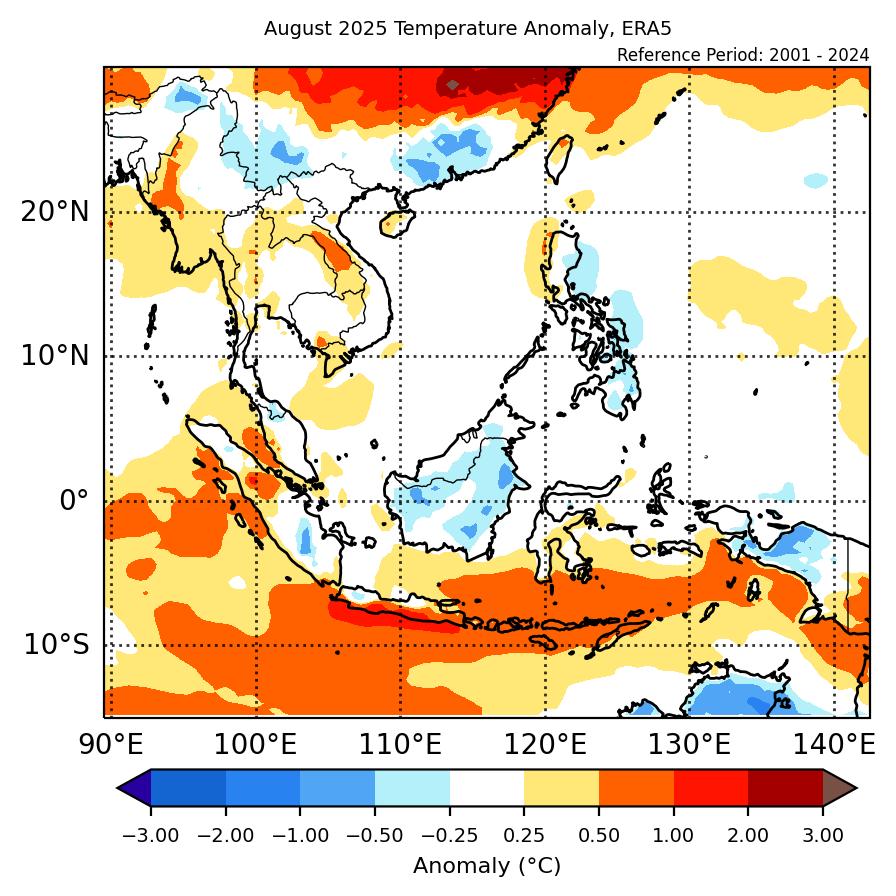Review of Regional Weather for August 2025
1. Overview
1.1 During August 2025, many parts of Southeast Asia experienced above-average rainfall (Figure 1). Most of the Maritime Continent recorded positive (wetter) anomalies in both datasets (GSMaP-NRT and CMORPH-Blended), although CMORH-Blended (Figure 1, right) recorded negative (drier) anomalies over much of the western Maritime Continent, and parts of Borneo, the southeastern Maritime Continent and northern Philippines. Over Mainland Southeast Asia, positive anomalies were recorded over the east , with a mix of below- to above-average rainfall elsewhere. The largest positive (wetter) anomalies over Southeast Asia were recorded over eastern Mainland Southeast Asia and the southeastern Maritime Continent.
1.2 The observed rainfall anomaly pattern of above-average rainfall over much of the Maritime Continent is consistent with the predictions from the subseasonal weather outlooks for August 2025 (4 – 17 Aug 2025 and 18 – 31 Aug 2025). The subseasonal weather outlooks also predicted a mix of below-and above-average rainfall over parts of Mainland Southeast Asia, in line with the observations. The observations are also somewhat consistent with the seasonal outlook for August 2025, which predicted an increase in chance of above-normal rainfall in the southern and eastern Maritime Continent.
1.3 Near- to above-average temperatures were recorded over Mainland Southeast Asia in August 2025, while below- to near-average temperatures were recorded over most of the Maritime Continent (Figure 2). The coldest anomalies (0.25°C – 1°C below average) were recorded over Borneo and the southeastern Maritime Continent, in line with the above-average rainfall anomalies. The warmest anomalies (0.5°C – 2°C above average) were recorded over parts of central Mainland Southeast Asia, Sumatra, and Java.
2. Climate Drivers
2.1 At start of August, a Madden-Julian Oscillation (MJO) signal was present in the Western Hemisphere (Phase 8) based on the RMM diagram (Figure 3). This signal propagated eastwards, reaching the Indian Ocean (Phases 2 and 3) by the second week of August. However, as the signal approached the Maritime Continent (Phase 4) in the last week of August, the signal rapidly weakened and became indiscernible. At this time of the year, Phases 8 and 1 tend to bring drier conditions to southern Mainland Southeast Asia and the Philippines, and to a lesser extent, Phases 2 and 3 can bring wetter conditions to the western Maritime Continent. However, these patterns are not visible in Figure 1, indicating other drivers likely had a stronger influence on the region’s rainfall.
2.2 There were signs of a negative Indian Ocean Dipole (IOD) developing in August 2025. Negative IOD events tend to bring wetter conditions to parts of the region, particularly the southern Maritime Continent, in line with the positive rainfall anomalies in Figure 1.





